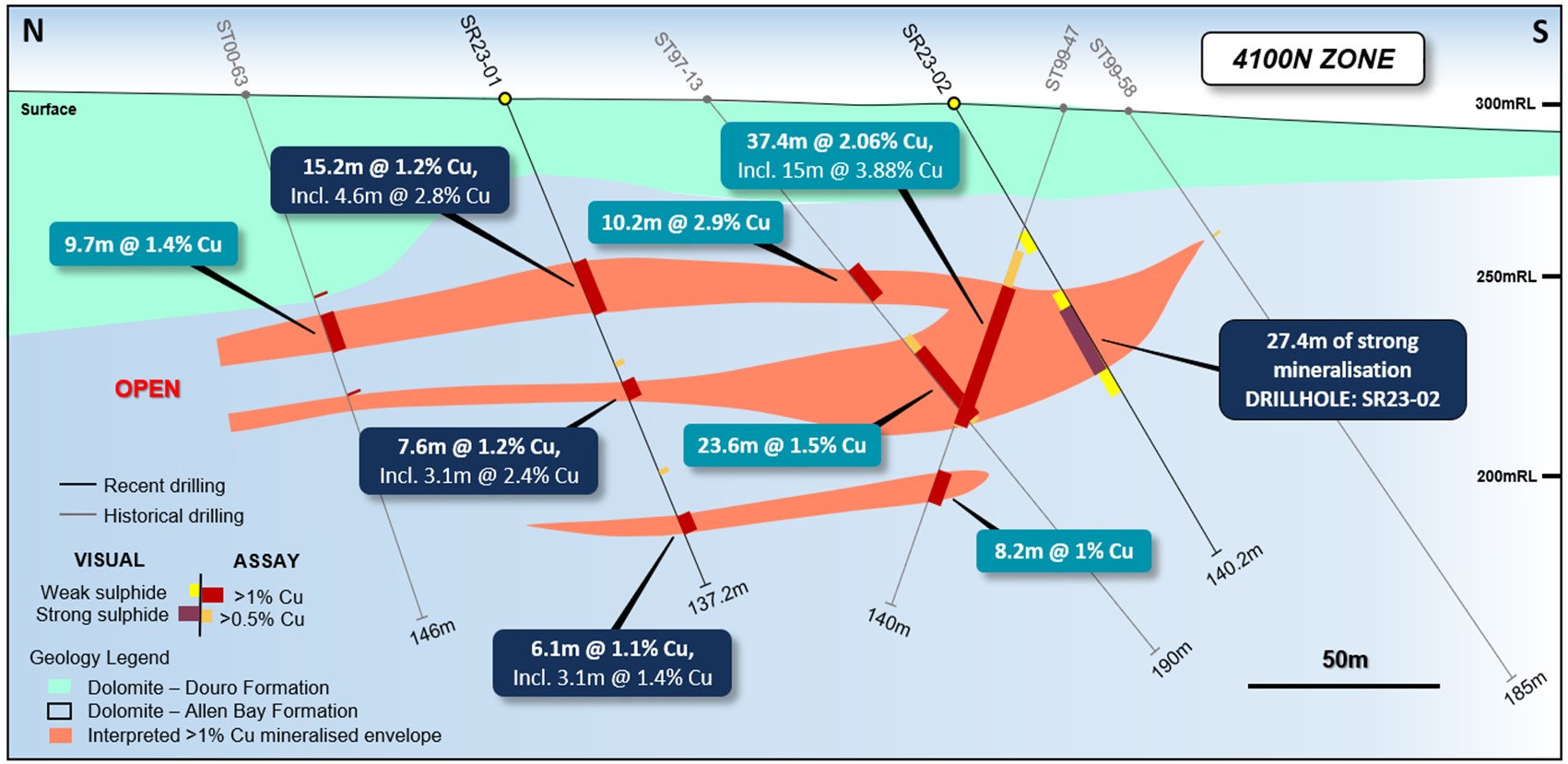-
Assays have been received for drill hole SR23-01, confirming a total of 28.9m of high-grade copper mineralization, comprising:
- 15.2m* @ 1.2% Cu, including 4.6m @ 2.8% Cu from 54.9m, and;
- 7.6m* @ 1.2% Cu, including 3.1m @ 2.4% Cu from 79.3m, and;
- 6.1m* @ 1.1% Cu, including 3.1m @ 1.4% Cu from 120.4m (*downhole length)
- Another eight Reverse Circulation (RC) drill holes have been completed at the 4100N Zone with all drill holes intersecting thick intervals of strong visual copper sulfide mineralization
- The recent drilling at the 4100N Zone has defined strong near-surface copper mineralization over 850m x 300m and remains open along strike
- RC drilling continues at Storm with further drill holes added to the resource definition program at the 4100N Zone
- All current drill samples have been sent to the laboratory for analysis
TORONTO, ON / ACCESSWIRE / May 23, 2023 / Aston Bay Holdings Ltd. (TSXV:BAY)(OTCQB:ATBHF) ("Aston Bay" or the "Company") reports initial assay results confirm thick intervals of copper mineralization from its ongoing delineation drilling program at the Storm Copper Project ("Storm" or the "Project") on Somerset Island, Nunavut, Canada. This is the second drilling program for American West Metals Limited ("American West"), who are the project operator, since entering an option agreement with Aston Bay in March 2021.
"Impressive results continue to come in from the ongoing exploration conducted by our partner American West Metals at Storm," stated Thomas Ullrich, CEO of Aston Bay.
"These assay results from the first reverse circulation drill hole of the season confirm the presence of significant copper mineralization, exceeding the initial visual estimates. This increases our confidence in both the core logging and our assumptions on the continuity of the mineralization at the 4100N Zone.
"We look forward to continuing good news from the results of the ongoing drilling, as well as from the interpretation of the recently completed geophysical programs now being processed."
Assay results have been received for drill hole SR23-01, the first hole of the current program, and confirm the presence of thick intervals of near-surface copper sulfides. The assays indicate that the mineralized intervals in SR23-01 have exceeded our visual estimations as reported in the Company's May 9th, 2023, press release.
The drilling program is ongoing and continues to intersect significant lengths of visual copper sulfide mineralization within the central and western portion of the known mineralized zone at the 4100N Zone (see Table 1). Due to continuing success and an expansion of the mineralized footprint, further drill holes have been added to the 4100N Zone program.
Visual estimates of mineral abundance should never be considered a proxy or substitute for laboratory analyses where concentrations or grades are the factor of principal economic interest. Laboratory assays are required to determine the presence and grade of any contained mineralization within the reported visual intersections of copper sulfides. Portable XRF is used as an aid in the determination of mineral type and abundance during the geological logging process.
Hole ID |
Prospect |
Easting |
Northing |
Depth (m) |
Azimuth |
Inclination |
Visual Sulfide Mineralization (m) |
SR23-01 |
4100N |
464991 |
8174285 |
137.2 |
180 |
-65 |
28.9 |
SR23-02 |
4100N |
464990 |
8174157 |
140.2 |
180 |
-59 |
27.4 |
SR23-03 |
4100N |
465041 |
8174251 |
151 |
178 |
-65 |
48.7 |
SR23-04 |
4100N |
465045 |
8174166 |
152.4 |
179 |
-69 |
30.6 |
SR23-05 |
4100N |
464899 |
8174146 |
131.1 |
180 |
-66 |
16.7 |
SR23-06 |
4100N |
464899 |
8174261 |
166.1 |
180 |
-69 |
15.2 |
SR23-07 |
4100N |
464805 |
8174203 |
137.2 |
180 |
-71 |
13.7 |
SR23-08 |
4100N |
464726 |
8174286 |
118.9 |
180 |
-69 |
13.7 |
SR23-09 |
4100N |
464726 |
8174206 |
164.6 |
180 |
-69 |
32 |
SR23-10 |
4100N |
464638 |
8174315 |
125 |
180 |
-70 |
10.6 |
SR23-11 |
4100N |
464667 |
8174223 |
140.2 |
180 |
-70 |
25.9 |
SR23-12 |
4100N |
465115 |
8174317 |
149.4 |
179 |
-73 |
12.2 |
SR23-13 |
4100N |
465051 |
8174321 |
175.3 |
180 |
-65 |
18.3 |
SR23-14 |
4100N |
464948 |
8174227 |
160 |
180 |
-65 |
22.9 |
SR23-15 |
4100N |
464853 |
8174167 |
121.9 |
180 |
-65 |
24.3 |
SR23-16 |
4100N |
465138 |
8174247 |
132.6 |
180 |
-70 |
7.62 |
SR23-17 |
4100N |
465139 |
8174173 |
129.5 |
180 |
-66 |
19.8 |
Table 1: 2023 program drill hole details and copper mineralization summary. Note - depth in metres has been converted from measurements in feet and is rounded. The "Visual Sulfide Mineralization" data is based on laboratory assays for SR23-01 and visual estimates for the remainder; length is downhole length.
ASSAYS CONFIRM GRADE AND THICKNESS OF COPPER MINERALIZATION
The assay results from drill hole SR23-01 have been received and confirm the intersection of thick intervals of near-surface copper sulfides (Figure 1).
The assayed intervals of SR23-01 closely match and exceed the intervals that were identified visually, validating the classification of strong visual copper sulfides (estimated to be >1% Cu) during the logging process.

DRILL HOLE SR23-01 DETAILS
SR23-01 was drilled to a downhole depth of 137.2m and was the first drill hole completed in the 2023 drill program. The drill hole forms part of a program that is designed to determine the resource potential of the near-surface 4100N Zone (Figure 2 & 3).
The drill hole is located in the central portion of the 4100N Zone and was designed to test the continuation of the mineralization between two historical drill holes, ST97-13 and ST00-63 (Figure 1).
SR23-01 intersected three zones of vein and fracture-style copper sulfide mineralization interpreted to be near horizontal and hosted within fractured dolomite.
The sulfide abundance and grade of the mineralized intervals within SR23-01 are very similar to that of the historical drill holes along section 465000E. This demonstrates good lateral continuity of the mineralized zones and is a positive outcome for the resource potential at the 4100N Zone.

Table 2 below summarises the significant intersections from drill hole SR23-01. Intersections are expressed as downhole widths and are interpreted to be approximately 90% of true width. A cut-off grade of 0.5% copper is used to define a significant intersection and is based on sulfide mineralogy, mineralization habit and expected beneficiation performance.
Hole ID |
From (m) |
To |
Width |
Cu % |
Zn % |
Ag g/t |
SR23-01 |
47.2 |
62.4 |
15.2 |
1.2 |
- |
2.3 |
Including |
54.8 |
59.4 |
4.6 |
2.8 |
- |
5 |
And |
76.2 |
77.7 |
1.5 |
0.6 |
- |
3 |
And |
79.3 |
86.9 |
7.6 |
1.2 |
- |
2.4 |
Including |
82.3 |
85.4 |
3.1 |
2.4 |
- |
3 |
And |
106.7 |
108.2 |
1.5 |
0.5 |
9 |
|
And |
120.4 |
126.5 |
6.1 |
1.1 |
- |
2.3 |
Including |
120.4 |
123.5 |
3.1 |
1.4 |
- |
2 |
Table 2: Summary of significant drilling intersections for drill hole SR23-01 (>0.5% Cu)
DRILLING SUCCESS CONTINUES
Eight additional drill holes have been completed at the 4100N Zone and continue to highlight the significant resource potential of the near-surface mineralization at Storm. Every drill hole to date within the current program (17 drill holes) has intersected thick intervals of visual sulfides, which have been confirmed to contain copper based on portable XRF analysis.
The mineralized footprint at the 4100N Zone has been shown by historical drilling to extend over an area of approximately 32 hectares. The Company considers that there is an outstanding opportunity to define a significant near-surface resource base that could support an initial low-cost, open-pit mining operation.

RECENTLY COMPLETED DRILL HOLE DETAILS
The latest drill holes (SR23-10, SR23-11, SR23-12, SR23-13, SR23-14, SR23-15, SR23-16 and SR23-17) have continued to intersect thick intervals of copper sulfide mineralization within the central and western parts of the 4100N Zone.
The mineralization is visually similar to the previous drill holes completed in the current program and is characterized by thick zones of strong copper sulfide mineralization within a broad mineralized package of vein, fracture and disseminated style mineralization. The mineralized horizons are relatively flat lying, laterally extensive in nature and remain open along and across strike.
Only the stronger visual mineralization has been reported in Table 1.
The dominant copper sulfide minerals observed within the drill holes to date are chalcocite, with chalcopyrite and bornite also present in abundance. Minor native copper and copper oxides (mostly malachite and cuprite) are also present.
The copper mineralization is hosted within distinctive horizons of the Allen Bay Formation, which is comprised of massive to thinly bedded dolomicrites.
Drill hole SR23-16 has intersected copper sulfide mineralized rocks of the Allen Bay Formation which are cut by a large fault in the lower portion of the drill hole. The interpreted fault consists of clay and fractured dolomudstone and is evident in the geophysical data as a north-south orientated feature. The mineralized copper horizons are continuous either side of the fault.
DRILL HOLE VISUAL LOGS
Intersections below are expressed as downhole lengths and are interpreted to be close to true widths. Visual estimates of sulfide type, quantity and habit should not be considered a substitute for laboratory assays. Portable XRF analysis has been used to confirm the nature of the sulfide intercepts. Laboratory assays are required to determine the widths and grade of mineralization as reported in preliminary geological logging.
Mineralization key: cc = chalcocite, chpy = chalcopyrite, br = bornite, py = pyrite, Cu = native copper, ct = cuprite, ml = malachite, sph = sphalerite, ga = galena. (5%) = visual estimation of sulfide content.
Hole ID |
From (m) |
To (m) |
Min |
Description |
SR23-10 |
0.0 |
25.9 |
Cape Storm Formation |
|
25.9 |
42.7 |
Allen Bay Formation |
||
42.7 |
51.8 |
py |
trace fine disseminated and patchy py (0.5%) |
|
51.8 |
61.0 |
py |
trace patchy py (0.2%) |
|
61.0 |
68.6 |
py, cc, co |
fine patchy py with cc veinlets, rare co (0.8%) |
|
68.6 |
76.2 |
py |
trace patchy py (0.2%) |
|
76.2 |
79.2 |
py, cc |
fine patchy py with cc veinlets (1%) |
|
79.2 |
85.3 |
py |
fine patchy py with fine cc veinlets (0.2%) |
|
85.3 |
96.0 |
massive to weakly laminated dolomudstone |
||
96.0 |
100.6 |
py |
trace fine disseminated py (0.1%) |
|
100.6 |
125.0 |
Allen Bay Formation |
Table 3: Summary geological log for drill hole SR23-10.
Hole ID |
From (m) |
To (m) |
Min |
Description |
SR23-11 |
0.0 |
33.5 |
Cape Storm Formation |
|
33.5 |
41.1 |
py, chpy, ml |
trace chpy and py veinlets, minor ml (0.8%) |
|
41.1 |
47.2 |
chpy, py |
abundant chpy veinlets and patchy py (1.5%) |
|
47.2 |
53.3 |
massive dolomudstone |
||
53.3 |
64.0 |
chpy, py, cc |
py and chpy veinlets with trace cc (0.8%) |
|
64.0 |
73.2 |
cc, br, chpy, py |
abundant cc veinlets with patchy br, chpy and veinlets of py (1.5%) |
|
73.2 |
80.8 |
cc, py, chpy |
trace veinlets of cc, py and chpy (0.5%) |
|
80.8 |
89.9 |
ml |
patchy minor ml (0.2%) |
|
89.9 |
96.0 |
py |
weakly dolomitised wackestone with fine disseminated py (0.8%) |
|
96.0 |
114.3 |
laminated dolowackestone with bioturbation |
||
114.3 |
140.2 |
Allen Bay Formation |
Table 4: Summary geological log for drill hole SR23-11.
Hole ID |
From (m) |
To (m) |
Min |
Description |
SR23-12 |
0.0 |
50.3 |
Cape Storm Formation |
|
50.3 |
54.9 |
py |
weakly recrystallized dolomudstone with fine py veinlets (2%) |
|
54.9 |
74.7 |
py, chpy, cc |
py veinlets, trace cc veinlets and patchy chpy (0.8%) |
|
74.7 |
89.9 |
cc, Cu, py |
cc veinlets with selvage and disseminated Cu, minor patchy py (0.5%) |
|
89.9 |
100.6 |
cc, Cu |
dark brown cherty dolomudstone to dolowackestone, cc veinlets and selvage Cu (0.8%) |
|
100.6 |
105.2 |
Cu |
abundant fine disseminated Cu (1%) |
|
105.2 |
112.8 |
cc, chpy, ga |
cc veinlets, patchy selvage chpy and ga (1%) |
|
112.8 |
121.9 |
cc, chpy, py |
fine disseminated py, cc veinlets and selvage chpy (0.5%) |
|
121.9 |
129.5 |
weakly fractured massive dolomudstone |
||
129.5 |
132.6 |
cc, Cu |
trace cc and Cu (0.2%) |
|
132.6 |
149.4 |
ct, ml |
Allen Bay Formation - laminated dolowackestone with fine copper oxides (0.2%) |
Table 5: Summary geological log for drill hole SR23-12.
Hole ID |
From (m) |
To (m) |
Min |
Description |
SR23-13 |
0.0 |
47.2 |
Cape Storm Formation |
|
47.2 |
57.9 |
py, chpy |
massive dolomudstone, py veinlets and trace patchy chpy (0.5%) |
|
57.9 |
62.5 |
ml, Cu |
fracturing with fine ml veinlets and trace Cu (0.2%) |
|
62.5 |
70.1 |
chpy, cc, py |
chpy and cc veins with patchy pyrite (2.5%) |
|
70.1 |
74.7 |
py, chpy |
trace patchy py and chpy (0.5%) |
|
74.7 |
80.8 |
cc, chpy, py |
fine cc veinlets and selvage chpy, trace py (1%) |
|
80.8 |
82.3 |
cc |
dense cc veins (3%) |
|
82.3 |
86.9 |
py, chpy |
fine patchy py and chpy veinlets (0.5%) |
|
86.9 |
89.9 |
cc |
dense cc veins (4%) |
|
89.9 |
93.0 |
cc, Cu, ml |
brown massive dolowackestone, fracturing with fine ml veinlets, cc and trace Cu (0.8%) |
|
93.0 |
137.2 |
ml |
trace ml in fine fractures (0.2%) |
|
137.2 |
175.3 |
Allen Bay Formation |
Table 6: Summary geological log for drill hole SR23-13.
Hole ID |
From (m) |
To (m) |
Min |
Description |
SR23-14 |
0.0 |
35.1 |
Cape Storm Formation |
|
35.1 |
45.7 |
py, chpy |
trace dissem py, chpy veinlets, blebby cu (0.2%) |
|
45.7 |
50.3 |
chpy |
trace chpy veinlets (0.5%) |
|
50.3 |
56.4 |
py, chpy |
trace patchy py, chpy veinlets (0.7%) |
|
56.4 |
61.0 |
Py |
trace disseminated py (0.1%) |
|
61.0 |
64.0 |
py, cc |
trace cc veinlets, patchy pyrite (0.2%) |
|
64.0 |
67.1 |
py, cc, br |
chpy veinlets, patchy br, disseminated py (1.2%) |
|
67.1 |
71.6 |
cc, chpy, br |
trace cc veinlets, disseminated chpy, patchy br (0.5%) |
|
71.6 |
77.7 |
cc, chpy, br |
cc veinlets, br veinlets, trace disseminated chpy (1.7%) |
|
77.7 |
86.9 |
cc, chpy ,Cu |
cc veinlets, patchy chpy, trace disseminated cu (2.5%) |
|
86.9 |
93.0 |
Cu |
trace disseminated cu (0.1%) |
|
93.0 |
102.1 |
py |
fine disseminated py (0.2%) |
|
102.1 |
125.0 |
brown massive dolowackestone |
||
125.0 |
132.6 |
cc, ml, ct |
trace cc veinlets, fine ml, patchy ct (0.1%) |
|
132.6 |
141.7 |
ml |
trace ml in fine fractures (0.2%) |
|
141.7 |
160.0 |
Allen Bay Formation |
Table 7: Summary geological log for drill hole SR23-14.
Hole ID |
From (m) |
To (m) |
Min |
Description |
SR23-15 |
0.0 |
22.9 |
Cape Storm Formation |
|
22.9 |
30.5 |
py, chpy |
dense disseminated py and patchy chpy (1%) | |
30.5 |
44.2 |
chpy, py |
patchy trace py and chpy (0.5%) |
|
44.2 |
51.8 |
cc, br, py, chpy |
cc and br veinlets, selvage py and chpy (1.5%) |
|
51.8 |
57.9 |
py, chpy |
patchy py and trace selvage chpy (0.5%) |
|
57.9 |
64.0 |
br, chpy, cc |
br veinlets with selvage chpy and trace cc veinlets (1.5%) |
|
64.0 |
71.6 |
cc, py br |
massive dolomudstone to dolowackestone, cc and br veinlets, selvage py (0.8%) |
|
71.6 |
74.7 |
cc, py, chpy |
cc and chpy veinlets, patchy py (1%) |
|
74.7 |
80.8 |
py, br, Cu |
fracturing with patchy py and trace selvage br and Cu (0.2%) |
|
80.8 |
89.9 |
br, py, chpy, Cu |
br veinlets with selvage chpy and py, trace Cu (0.8%) |
|
89.9 |
93.0 |
ga, py |
trace ga veinlets and patchy py (0.5%) |
|
93.0 |
108.2 |
py |
trace patchy py (0.2%) |
|
108.2 |
121.9 |
Allen Bay Formation |
Table 8: Summary geological log for drill hole SR23-15.
Hole ID |
From (m) |
To (m) |
Min |
Description |
SR23-16 |
0.0 |
36.6 |
Cape Storm Formation |
|
36.6 |
45.7 |
py, chpy |
fine patchy py, trace chpy veinlets (0.2%) |
|
45.7 |
57.9 |
ml |
trace ml on fractures (0%) |
|
57.9 |
62.5 |
py, chpy, ml |
fine patchy py, trace chpy veinlets, ml on fractures (0.2%) |
|
62.5 |
67.1 |
Cu, ml |
trace disseminated Cu, ml on fractures (0.1%) |
|
67.1 |
70.1 |
Cu, ct, ml |
disseminated Cu, trace patchy ct, ml on fractures (0.3%) |
|
70.1 |
74.7 |
py, chpy, ml |
fine patchy py, trace chpy veinlets, ml on fractures (0.2%) |
|
74.7 |
80.8 |
py, ml |
fine patchy pyrite, ml on fractures (0.1%) |
|
80.8 |
112.8 |
FAULT - brown massive dolowackestone with wide intervals of clay gouge |
||
112.8 |
132.6 |
Allen Bay Formation |
Table 9: Summary geological log for drill hole SR23-16.
Hole ID |
From (m) |
To (m) |
Min |
Description |
SR23-17 |
0.0 |
29.0 |
Cape Storm Formation |
|
29.0 |
41.1 |
py |
massive dolomudstone, selvage py (0.5%) |
|
41.1 |
53.3 |
chpy, py |
selvage chpy and patchy py (0.8%) |
|
53.3 |
59.4 |
py |
trace selvage py (0.1%) |
|
59.4 |
71.6 |
cc, br, chpy, py |
cc veins, trace br veinlets, patchy chpy and py (2%) |
|
71.6 |
76.2 |
br, chpy, py, cc |
massive cherty dolomudstone, br veinlets, selvage chpy and py, trace cc veinlets (1.5%) |
|
76.2 |
80.8 |
chpy, py |
trace selvage chpy and py (0.5%) |
|
80.8 |
82.3 |
chpy, ga |
micro-breccia, chpy veinlets with selvage ga (0.5%) |
|
82.3 |
86.9 |
ml |
patchy ml veinlets (0%) |
|
86.9 |
89.9 |
cc, Cu, py |
cc veinlets, selvage Cu and py (1%) |
|
89.9 |
96.0 |
massive dolomudstone with pervasive weak fracturing (0%) |
||
96.0 |
99.1 |
py, chpy |
trace disseminated py and chpy (0.5%) |
|
99.1 |
111.3 |
massive dolomudstone with pervasive weak fracturing (0%) |
||
111.3 |
129.5 |
Allen Bay Formation |
Table 10: Summary geological log for drill hole SR23-17.
PLANNED PROGRAM
- Drilling at the 4100N Zone continues, with further drill holes added to the initial program to follow up open areas and to expand the mineralized footprint. This program will be followed by resource definition drilling at the 2200N and 2750N Zone, where the 2022 drill program intersected high-grade copper sulfides close to surface including 41m (core length) @ 4.18% Cu from 38m (ST22-05) downhole.
- A third batch of drill samples has been sent to the laboratory, with results expected within 4-5 weeks.
- Processing and interpretation of the moving loop electromagnetics (MLEM) and gravity geophysical survey data is continuing. Diamond drilling will be used to test new high-priority exploration targets identified from these surveys; the core drilling is expected to commence after the completion of the resource drilling.
- Sorting and beneficiation test work for a potential direct shipping product operation is continuing with results to follow shortly.
- Environmental baseline surveys will begin in the Storm area during Q3 2023
About the Storm Copper and Seal Zinc-Silver Projects, Nunavut
The Nunavut property consists of 173 contiguous mining claims covering an area of approximately 219,257 hectares on Somerset Island, Nunavut, Canada. The Storm Project comprises both the Storm Copper Project, a high-grade sediment hosted copper discovery (intersections including 110m* @ 2.45% Cu from surface and 56.3m* @ 3.07% Cu from 12.2m) as well as the Seal Zinc Deposit (intersections including 14.4m* @ 10.58% Zn, 28.7g/t Ag from 51.8m and 22.3m* @ 23% Zn, 5.1g/t Ag from 101.5m). Additionally, there are numerous underexplored targets within the 120-kilometre strike length of the mineralized trend, including the Tornado copper prospect where 10 grab samples yielded >1% Cu up to 32% Cu in gossans.
*Stated drill hole intersections are all core length, and true width is expected to be 60% to 95% of core length.

Qualified Person
Michael Dufresne, M.Sc., P.Geol., P.Geo., is a qualified person as defined by National Instrument 43-101 and has reviewed and approved the scientific and technical information in this press release.
About Aston Bay Holdings
Aston Bay is a publicly traded mineral exploration company exploring for high-grade copper and gold deposits in Virginia, USA, and Nunavut, Canada. The Company is led by CEO Thomas Ullrich with exploration in Virginia directed by the Company's advisor, Don Taylor, the 2018 Thayer Lindsley Award winner for his discovery of the Taylor Pb-Zn-Ag Deposit in Arizona. The Company is currently exploring the high-grade Buckingham Gold Vein in central Virginia and is in advanced stages of negotiation on other lands with high-grade copper potential in the area.
The Company is 100% owner of the Storm Project property, which hosts the Storm Copper Project and the Seal Zinc Deposit and has been optioned to American West Metals Limited.
About American West Metals Limited
AMERICAN WEST METALS LIMITED (ASX: AW1) is an Australian clean energy mining company focused on growth through the discovery and development of major base metal mineral deposits in Tier 1 jurisdictions of North America. Our strategy is focused on developing mines that have a low-footprint and support the global energy transformation.
Our portfolio of copper and zinc projects in Utah and Canada include significant existing resource inventories and high-grade mineralization that can generate robust mining proposals. Core to our approach is our commitment to the ethical extraction and processing of minerals and making a meaningful contribution to the communities where our projects are located.
Led by a highly experienced leadership team, our strategic initiatives lay the foundation for a sustainable business which aims to deliver high-multiplier returns on shareholder investment and economic benefits to all stakeholders.
For further information on American West, visit: www.americanwestmetals.com.
FORWARD-LOOKING STATEMENTS
Statements made in this news release, including those regarding the Option Agreement, grant of the Option and the expected closing date, American West's interest in the Storm Project and its other acquisitions and plans, plans for the upcoming field season, management objectives, forecasts, estimates, expectations, or predictions of the future may constitute "forward-looking statement", which can be identified by the use of conditional or future tenses or by the use of such verbs as "believe", "expect", "may", "will", "should", "estimate", "anticipate", "project", "plan", and words of similar import, including variations thereof and negative forms. This press release contains forward-looking statements that reflect, as of the date of this press release, Aston Bay's expectations, estimates and projections about its operations, the mining industry and the economic environment in which it operates. Statements in this press release that are not supported by historical fact are forward-looking statements, meaning they involve risk, uncertainty and other factors that could cause actual results to differ materially from those expressed or implied by such forward-looking statements. Although Aston Bay believes that the assumptions inherent in the forward-looking statements are reasonable, undue reliance should not be placed on these statements, which apply only at the time of writing of this press release. Aston Bay disclaims any intention or obligation to update or revise any forward-looking statement, whether as a result of new information, future events or otherwise, except to the extent required by securities legislation.
For more information contact:
Thomas Ullrich, Chief Executive Officer
thomas.ullrich@astonbayholdings.com
(416) 456-3516
Sofia Harquail, IR and Corporate Development
sofia.harquail@astonbayholdings.com
(647) 821-1337
SOURCE: Aston Bay Holdings Ltd
View source version on accesswire.com:
https://www.accesswire.com/756447/Aston-Bay-Announces-Initial-Assays-Confirming-Thick-Intervals-of-Copper-Mineralization-at-the-Storm-Copper-Project-Nunavut






